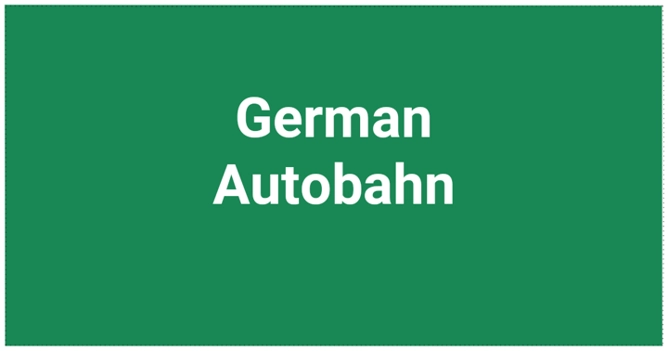
German Autobahn - As Fast As You Can [2024] - Navigate Germany
The German autobahn has got legendary status due to its speed fantasies, so many foreigners want to try it. You must be well prepared for it, so follow this guide.
German Autobahn Defined
Autobahns are German-controlled highways (Bundesautobahnen) or Federal highways, a network of the largest highway that goes through 16 German states including Baden, Bavaria, Saarland, Wurttemberg, Hesse, Berlin, and Saxony. There are two directional lanes divided by green strips with a concrete safety barrier or steel crash barriers. Autobahns are always höhenfrei, which means more than two traffic routes do not cross at the same point which makes the speed better.
History of Autobahn
The idea of the autobahn originated in the mid 1920s to build a network for uninterrupted travel in the absence of pedestrians, bicycles, and animal transportation carriers, but not executed until 1929. First autobahn opening was held between Düsseldorf and Opladen.
In 1932, Adolf Hitler constructed the first crossroad-free motorway (known as A555) between Cologne and Bonn with a maximum speed of 120 km/hr, but very few cars were reaching the speed of more than 60 km/h. The construction was seized by the Nazis due to World War II which completely halted by 1942. Many autobahns were incomplete until the Reunification of West and East Germany in 1990.
Features of The German Autobahn
The German Autobahn is the safest highway system with no speed limit. Here are the features;
Speed Limit
There is no speed limit so it is not illegal to drive faster. However, drivers must maintain the speed above 80 km/hr and below the recommended limit for safe travel. There are areas where speed restrictions apply such as construction areas, at junctions, on a dangerous part of the road, or around the city entry/exit points. Follow the posted restrictions until you see an end-of-limit sign or other speed limit sign.
Collision Prevention
There is a green median landscape separating the two lanes to avoid accidents. The Autobahn also has guardrails down the middle and concrete barriers on the new sections to avoid a head-on collision. Drivers must never drive in the left lane for travel but use it to pass only.
Traffic Emergency
All drivers must leave the space in the middle of the road for ambulances, police, or fire engines in case of accidents or other emergencies. Drivers must keep the car doors closed and should never stand in the emergency lane to avoid any collision.
Road Tolls
Passengers can drive without paying the toll, but vehicles of weight 7.5 tons and above must pay it using the “toll collect”. Charges also apply If you cross the border into either France, Austria, or Switzerland.
Safety Measures on Autobahn
Drivers must know all official and unofficial laws of driving on an autobahn. Here are some laws to increase safety.
Check Side View Mirrors
Do not forget to check the left side-view mirrors as cars can suddenly overtake you at a speed of more than 100 mph. Seeing the side mirrors before changing lanes can save you from serious accidents.
Right Lane For Slow Drivers
Never stay in the left lane if your speed is slow as the left lane is for high-speed vehicles. Move to the right lane if a car with high speed flashing the beems.
Use Indicators or Blinkers
Use blinkers when changing a lane to avoid collision. Push the control lever to activate indicators that conveys the message to the driver behind you so they can slow down. Most blinkers turn off automatically after a few seconds or when the turn is made.
Obey The Speed Limits
You can drive at the highest speed in a few areas but restrictions on speed limits are increasing with time. Check the speed signs on the road and change your speed according to the requirements. Speed limits include 120 km/h, 110 km/h, or lower near urban areas. If you don’t follow, you will be caught by hidden radar devices and unmarked police cars and will pay the heavy fines.
Keep Certain Distance
Maintain a specific distance between vehicles according to the traffic authority’s recommendations. If you disobey, you will pay the penalty up to €400. Ideal distance is to divide the speed of your car by two and the result is the distance between two vehicles in meters.
Taking Breaks
While driving on the autobahn, take a break after every two hours to avoid fatigue. Take breaks at different rest areas (Raststätten) with restaurants, gas stations, picnic tables, shops, and toilets. Service prices at these rest spots are always affordable.
Important Considerations to Drive on German Autobahn
Legal Documents
Have these documents to drive on the autobahn:
- Driving license
- car insurance proof
- Details of vehicle registration
- ID or Passport
Safety Items
Have some safety items to drive on an autobahn:
- Warning triangle
- First-aid kit
- Reflective vest
You can buy this from Amazon or any hardware shop.
Road Signs
- Ausfahrt = Exit.
- Exits - on the right.
- Long stretches without street lights in rural areas.
- North-South highways are odd-numbered
- East-West highways are even-numbered.
- Hazard warning flashers to announce upcoming traffic jams.
Conclusion
German Autobahn have a great reputation across the country and allow drivers to experience high speed driving. Every driver must follow the traffic laws and necessary safety measures to avoid an accident that can cost thousands of dollars or worse, your life.

Jibran Shahid
Hi, I am Jibran, your Fellow Expat living in Germany since 2014, With my 10 years of experience, my aim is to bring you the well researched guides about life in Germany


![German Handelsregisternummer (Commercial Register Number) - [2024]](https://navigategermany.com/images/a-german-handelsregisternummer/feature-image-668w.webp)


